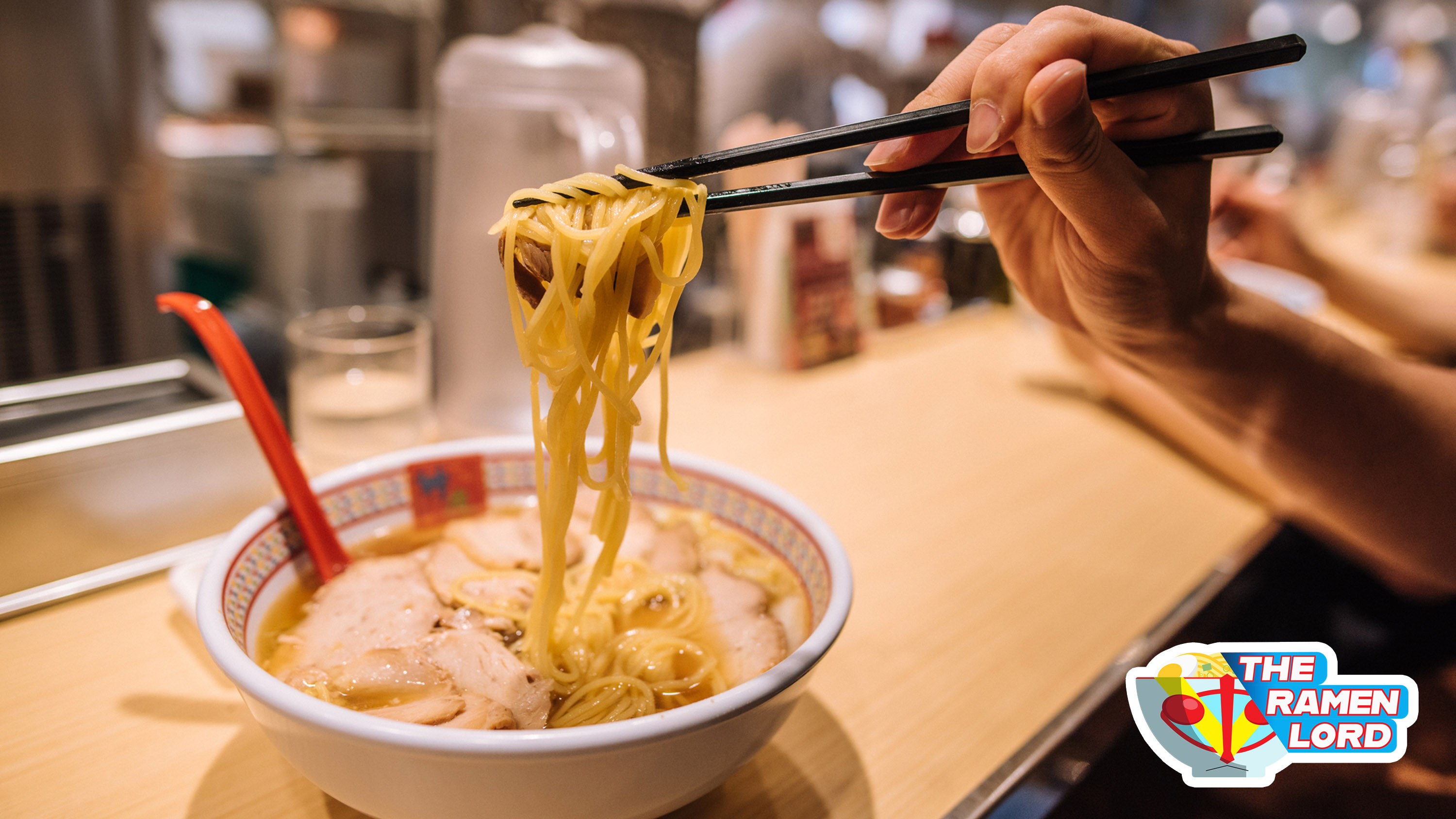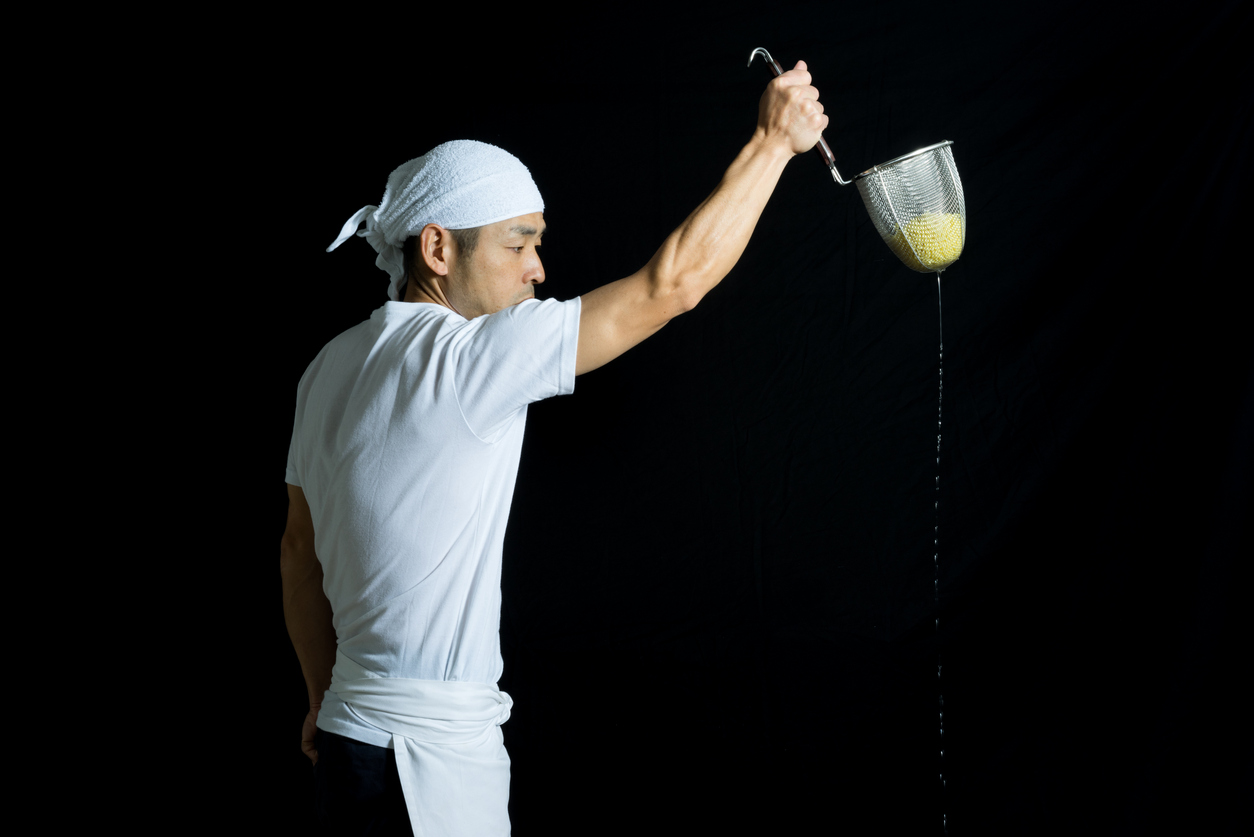What Makes Ramen Noodles So Special?
Welcome to The Takeout's Asian Noodles Week, a tribute to the O.G. pasta bowl.
We've broken down ramen's components: the broth, the tare, the richness added via aroma oil, and popular toppings like the "ajitama" egg and pork chashu. But nothing is more integral to ramen than its noodles. It is the tie that binds. It's why you can have many different styles of ramen, such as tsukemen (where the soup is on the side) or abura soba (with no soup at all)—but the connective thread is the noodle, full stop.
But what exactly makes ramen noodles, well, ramen noodles? After all, they come in all shapes, sizes, and textures. In Sapporo they're brightly yellow and densely curled; in Hakata they're extremely thin, brittle, and white. They can be springy or taut, wiry or thick, curly or straight, dark yellow or bright white, sometimes even tan. They can be hot or cold, long or short, translucent and dense or spongey and opaque.
What sets ramen noodles apart from other wheat-based noodles such as pasta, and what is arguably its defining characteristic, is kansui—a combination of several specific alkaline salts.
Ramen noodles are heavily based on Chinese alkaline noodles, a broader catch-all term for noodles that contain some alkaline ingredient in the dough. Think of lo mein's pliant, slightly yellow, chewy noodles. And depending on the old-school nature of the ramen shop you visit, they may still call the noodles "chukka soba" or "chukka men" (Chukka is a term for Chinese products, and "soba" and "men" are both terms for noodles in Japanese). They tend to be lower in hydration, mildly salted, and narrow in shape—around 1.5mm is standard. But, as we've seen in my other articles exploring ramen, there are very few rules here.
(It's worth clarifying that ramen is not the same as Chinese "la mien," or hand-pulled noodles, despite a similar name. There is some debate over the etymology of the term "ramen" itself, but the recipe has consistently been quite different from hand pulled noodles. Ramen noodles just do not have the same water content—If you took a typical ramen noodle dough and tried to pull it by hand, you'd be trying to pull crumbly, sandy flour. It wouldn't work well.)
Kansui is the only true requirement for ramen noodles. The Japanese government prohibits the labeling of noodles as "ramen" noodles unless they contain at least .01% kansui. I know this sounds pedantic, like it's just an alkaline dough, so who cares? But it matters.

The science
Kansui does two critical things to wheat doughs like those that make ramen noodles:
- Improves the rigidity of gluten. Gluten, the mesh of protein in wheat that develops in the presence of water, increases in tensile strength in slightly acidic or basic environments. This adjustment to gluten strength is why sourdough works: That acidic environment is actually helpful for the production and strengthening of gluten. By contrast, if the environment is too acidic or basic, gluten's ability to maintain its structure diminishes. Kansui is basic, so it increases gluten's tensile strength.
- Adds flavor. The characteristic eggy quality of ramen is not derived from eggs, which may or may not be included. The flavor comes from the alkaline salts. But if you add too much, or don't add the right kinds, they can taste more soapy than eggy.
You'll notice I don't mention color. While it's true that kansui can give the noodle a slight light yellow hue (as Harold McGee mentions), the color is very mild. Most ramen noodles with that deep, dark yellow color actually get it from... drumroll please... food dye. Surprise! Everything you know is a sham!
Kansui is almost always comprised of some ratio of two alkaline salts: Potassium carbonate and sodium carbonate. Kansui can include other ingredients too, such as buffering agents or other preservatives, but 99% of the time, the two combination of potassium carbonate and sodium carbonate are used as the bulk of the alkaline salt composition. Manufacturers in Japan have identified specific ratios of these two salts, along with those mentioned other salts or buffers, to give ramen noodles their characteristic texture and flavor.
So why these two salts specifically? If it's all about alkalinity, why not just use something like lye or even baking soda? These salts have specific effects on the noodle:
- Potassium carbonate alters the texture of the noodle, giving it a firmer, tighter texture.
- Sodium carbonate is for flavor, while also giving it a softer, more chewy texture.
- For thinner, more brittle noodles, increase the ratio of potassium carbonate
- For thicker, more chewy noodles, increase the ratio of sodium carbonate
There is, indeed, a difference between firmness and chewiness when it comes to noodles. Often, we conflate the two, especially with the broad terminology "al dente." In reality, the sensation is different on the palate. Firmness is the amount of force required to sever a piece of food. Chewiness is the amount of force a food can withstand while remaining elastic, it is the elastic resistance a food provides.
As an example, chewing gum does not require a lot of force to split apart, but it's considered chewy. By contrast, a jawbreaker is really firm, but you wouldn't call it chewy. Ramen noodles can be the same way. In a Hakata-style noodles, the noodle breaks pretty cleanly on the teeth when you bite down—it's firm. For a Sapporo noodle, the dough bends and yields between the teeth—it's chewy.
(I know this can seem confusing, but if you eat enough bowls of ramen, this'll start to make sense. So this is your excuse to gorge. For self-education!)
Kansui salts therefore have drastic effects on the noodle's final texture, hence their importance. The reasons for the different effects on the dough are not entirely understood. From the food scientists I've spoken to, it has something to do with the specific chemical composition of the respective salts, which directly affects the gluten and flavor of the dish. This cannot be replicated with other salts, which is why each is necessary in the dough.
So, should you want to make your own ramen noodles, you'll want some combination of the above. Ideally you have them in separate, dry form, so that you can adjust the ratios as desired, all without changing the other aspects of the recipe you enjoy, like flour type, salt type, or how much water you're adding.
There are some rules of thumb for using each salt:
Now, that said... I don't think you should make noodles at home if you can help it. Making ramen noodles at home is a royal pain. Take it from me, I've published a lot of noodle recipes over the years (this one is over five years old, and really outdated!). But knowing a little bit more about kansui can help you understand what exactly the type of noodle you're eating. Does it have a strong, eggy quality? Probably more sodium. Does it have a firmer bite? Probably more potassium. It'll also help you understand that, really, there isn't a true single way for a ramen noodle to exist, so long as it has a little alkalinity to help it along.

Which noodle for which soup?
All of this just creates a new question: How do you pair noodles with soup? With so many variations of ramen, how do chefs choose?
My general rule: As the soup increases in richness and viscosity, the noodle must increase in either firmness, thickness, flavor, or chewiness, or some combination thereof. Kansui affects all of these except thickness.
An increase in any one of these aspects of the noodle gives something I call "presence." That is, you notice the noodles more in your mouth as you eat. Maybe they have more flavor, maybe they're thicker so you get less broth and more noodle per bite. Or maybe they're really chewy, so they linger in your mouth as you chomp away. More "presence" means you aren't as overwhelmed by the broth.
As an example, a Hakata noodle isn't the thickest noodle, nor is it very alkaline, but it's really, really firm, snappy almost, so it helps cut right through the richness of, say, a tonkotsu broth. Sapporo miso ramen, also rich but often intensely flavored, needs the high-alkaline flavor profile of its dense and curly yellow noodle to balance it out. Conversely, many of the top-tier shoyu ramen shops in Japan are using lower-protein flours in their noodles, and cutting back on kansui, to create noodles that are soft and gentle on the palate.
At the end of the day, there aren't hard rules here. I've had immensely thick, chewy noodles in the cleanest broths, and really thin noodles in thick, monstrous soups. Sometimes, just like any dish, it's up to the cook and what they personally prefer. This, really, is the spirit of ramen.
In our next column, we'll take everything we've learned so far about ramen and build our first bowl.

